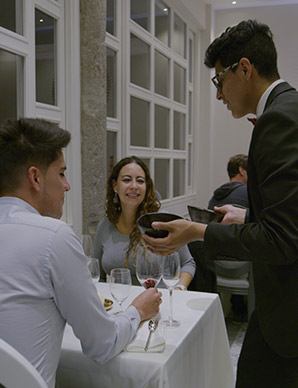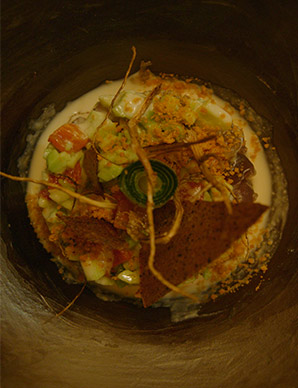Ecuadorian food is the product of centuries of trade, conquest, and cultural fusion: ancestral traditions mixed with Spanish cuisine, left simmering for four centuries. And then consider that we live in one of the most biodiverse countries in the world, and the variety of fruits, vegetables, and grains available here are enough to make your head spin. Fruits like maracuyá, naranjilla, taxo, and tree tomato. Dozens of varieties of potatoes and corn.
With a-la-carte options as well as a full tasting menu, Chef Alejandro Chamorro wants you to understand what Ecuadorian cuisine is all about, even if this is the only time you’ll ever visit the country. Nuema, the award-winning restaurant that Chamorro and his wife Piedad Salazar have run in Quito for that past years, will now join Illa Experience Hotel in San Marcos. Chamorro is thrilled about the new collaboration and location: he believes that any project that has to do with valuing traditional gastronomy should start in the historic center. This part of the city has a strong link with the processes formation and renovation of these traditions over time.
Gastronomic experiences have the power to transport people across the boundaries of time and culture. But to do so it has to tell a story, and that’s why innovation is so important in Chamorro’s brand of auteur cuisine. “We couldn’t just make a nicely presented guatita,” (a typical Andean dish of tripe in a peanut sauce and potatoes) “because it didn’t tell you anything. It told you something that had already been done.”
Understanding the Food Chain

The concept behind Nuema is to value the traditional ingredients that Ecuador has to offer. That means treating the produce and animal products, as well as the people and processes that great and harvested them, with the utmost respect. The first step in developing any Nuema dish is making a personal contact with the farmer. “You have to recognize the added value that farmers bring to the produce,” Chamorro insists. “A cook without ingredients can’t do anything.”
When they buy seafood, they work only with small-scale, environmentally responsible fisherman. “We try to use all of the products that come out of the ocean, not discriminating one over the other.” Chamorro says that if he insisted in only cooking with, say, Chilean sea bass, because that’s what people are used to eating, then he would be wasting part of the fish that were caught. “I adapt to the product and change the menu accordingly. That way what we eat can be sustainable.” For Chamorro, the relationship between chef and farmer, or chef and fisherman, is a collaborative one. “That is the real avant-garde. You have to know where your food comes from.”
Traditional dishes with modern style

Once you place your primary focus on the ingredients themselves, rather than on a certain recipe or process, you open yourself up to a whole new range of culinary techniques. Taste, for example, this Nuema take on the traditional Ecuadorian dish hornado. The plate of hornado that you would find at a market would consist of chunks of seasoned pork pulled of a whole roasted pig, accompanied by llapingachos, mashed potato and cheese tortillas fried in achiote oil. It’s usually garnished with some chopped onions and tomatoes and an agrio sauce.
Chamorro explains that pork is one of the most important food products in Latin America, often related to a humble beginning. In his preparation, Chamorro roasts a 21-day suckling pig at 82 degrees (in a temperature-controlled environment) for 36 hours. “We use the same spices that you would use to marinate a tradition hornado. So we’re getting the same flavours that we would get from a typical hornado, but we do it using modern techniques.”
Instead of the typical potato base for a llapingacho, Chamorro chooses the under-utilized zanahoria blanca, (the Andean root vegetable Arracacia xanthorrhiza, referred to in Ecuador as a “white carrot”) and steams it to retain all of its unique flavors. For a garnish, Chamorro uses another little-known Andean tuber, the oca, thinly sliced and pickled in traditional spices like cloves and ishpingo.
Nuema’s dish is, on one level, the same dish that you’d find in the market, but transformed into more delicate flavours by using modern techniques and ancient. Eating at Nuema is a singular experience, offering you Ecuadorian cuisine like you’ve never tried before.
